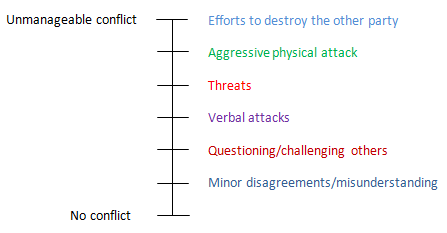Conflict Process
The conflict process consists of five stages as shown in figure.
1. Potential opposition or incompatibility.
2. Cognition and personalization.
3. Intentions.
4. Behavior.
5. Outcomes.

Potential Opposition or Incompatibility
It includes the presence of a condition that creates opportunities for conflicts to arise. The conditions that can cause conflict are of 3 types.
Communication: Insufficient exchange of information and noise in the communication channel are all barriers of communication and create conditions for conflicts. Potential for conflict increases when either too little or too much communication takes place. The channel for communication also has an influence on the conditions causing conflict.
Structure: Size and specialization act as a force to stimulate conflict. The larger the group, the more specialized their activities, the greater the likelihood of conflict. Tenure and conflict have been found to be inversely related. There is increased conflict when group members are younger and when turnover is high.
Groups within the organizations have diverse goals. E.g.: Quality control department is concerned with improving the quality of products while marketing department is concerned with selling large no of goods and increasing the revenue. This diversity of goals also is a source of conflict.
Personal variables: This includes the value systems each person has and personality characteristics each possess. Difference in value systems are a source of conflict, as they result in disagreement between members of the group.
Cognition and Personalization
This step in the conflict process is important because it is in the step the parties decide what the conflict is done. Awareness by one or more parties about the existence of conditions that create opportunities for conflict to arise is called perceived conflict. Emotional involvement in the conflict creating anxiety, frustration and enimity is called felt conflict. Positive emotions help in finding solutions to solve conflicts while a negative emotion enhances the conflict.
Intensions
These are the decisions to act during conflict. There are five conflict handing intensions. They are:
a. Competing: (assertive and unco-operative): It is a desire to satisfy ones own interest regardless of its impact on the other party. It includes desire to achieve ones own goal at the sacrifice of others goal, attempting to convince others that your conclusion is correct and attempting to make someone else accept the blame for the problem.
b. Collaborating (assertive and co-operative): It is a desire to satisfy all the parties. It includes attempting to find a win-win situation that allows both parties goals to be achieved.
c. Avoiding: (unassertive and uncooperative): It is a desire to suppress a conflict. It includes ignoring the conflict and avoiding others with whom one disagrees.
d. Accommodating (unassertive and cooperative): It is a willingness to place the opponent's interest above ones own. It includes sacrificing ones goal to maintain other party's goals.
e. Compromising: It is situation in which each party conflict is willing to give up something. There is no clear loser or winner.
Behavior
In this stage, each party's intentions are implemented. This is an interactive stage.
Figure shows conflict behavior:

Conflict at the lower part continuum is small conflicts. Conflicts in the upper part of the continuum are highly destructive. Strikes, riots, and wars fall in upper range.
Outcome
The action-reaction between conflicting parties results in two kinds of outcomes.
i) Functional outcomes: Conflict results in improved performance of the group. It improves the quality of decisions, brings about creativity and innovations, encourage interests and curiosity among group members.
ii) Dysfunctional outcomes: It reduces the effectiveness of the group. It is as a result of uncontrolled opposition. It leads to destruction of the group. It reduces group communication and group coordination.
Average Acceleration Calculator
Average acceleration is the object's change in speed for a specific given time period. ...
When an object falls into the ground due to planet's own gravitational force is known a...
In Mathematics, the permutation can be explained as the arrangement of objects in a particular order. It is an ordered...
A rectangle can be explained as a 4-sided quadrilateral which contains equal opposite sides. In a rectangle
A three sided polygon which has three vertices and three angles is called a triangle. Equilateral triangle...







